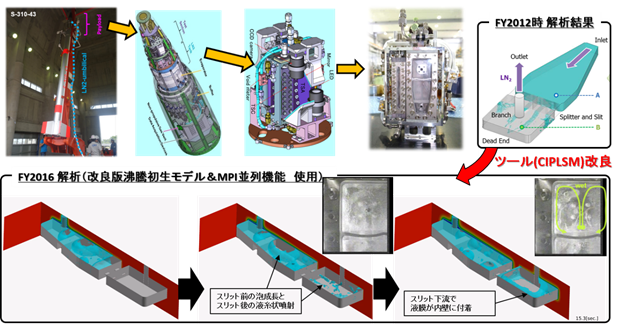Numerical Simulation of Propellant Management for Rockets and Spacecrafts
JAXA Supercomputer System Annual Report April 2016-March 2017
Report Number: R16E0084
- Responsible Representative: Eiji Shima(Research Unit III Research and Development Directorate)
- Contact Information: Yutaka Umemura(umemura.yutaka@jaxa.jp)
- Members: Ryutaro Furuya, Tetsuji Ogawa, Hiroaki Amakawa, Tomoyuki Deura, Takayuki Ito, Hideyo Negishi, Yoichi Ohnishi, Miki Nishimoto, Yu Daimon, Hiroshi Ishihara, Ashvin Hosangadi, Jeremy Shipman, Masaaki Ino, Jai Singh Sachdev, Osamu Fukasawa, Shinji Ohno, Andrea Zambon, Takenori Nakajima, Yuka Akimura, Takashi Amemiya, Hironori Fujiwara, Hiroumi Tani, Takuya Iimura, Keiichiro Fujimoto, Tetsufumi Ohmaru, Akiko Kotani, Taroh Fukuda, Mayu Matsumoto, Masashi Toyama
- Subject Category: Space(Rocket,Space transportation)
Abstract
In order to improve the payload capacity of spacecraft, it is necessary to optimally design the propellant amount on board under the uncertainty of cryogenic propellant evaporation and low gravity environment. This project has been conducting numerical simulation development for the cryogenic propellant thermal flow analysis. By understanding the internal heat flow of the propellant tank and the feed line, it is linked to the change of propellant system design and operation.
Goal
The technology of multiple ignition after long-duration coast must be improved to increase the payload capacity of launch vehicles using cryogenic propellants. This project has developed the thermal behavior simulation for space launch vehicle’s propellant system to evaluate a new flight operation as chill-down engine and tank pressurization.
Objective
For consideration to realize the upgrade of flight operation such as long-duration coast and multiple ignition, this project has been conducting numerical simulation development for the cryogenic propellant thermal flow analysis with temperature prediction one order higher than results obtained in FY2012.
References and Links
N/A
Use of the Supercomputer
One-dimensional thermal analysis has been carried out in rocket development, and it has reached the limit of prediction accuracy. By conducting detailed thermal flow analysis using supercomputer, this project extracts unconsidered phenomena on conventional analysis to improve the design tool.
Necessity of the Supercomputer
In the chill-down process analysis before engine re-ignition, the calculation lattice is as small as several millimeters in order to reproduce boiling, and it is necessary to solve operation time of 500 seconds or more. The calculation load of this chill-down process analysis is so large that it requires the supercomputer’s performance.
Achievements of the Year
Verification of numerical simulation has been conducted on LN 2 boiling experiment on a sounding rocket S- 310-43. At the beginning of the development of simulation tool, analysis of flow in the test section without consideration of boiling was the technology limit, but it was possible to reproduce the experiment through improvement of the physical model and MPI parallel correspondence. The tool verified by this analysis has been used for the chill-down process of the upper stage engine of H-IIA, it has been trying to obtain correspondence between flight temperature data and internal flow phenomena.
Publications
Non peer-reviewed articles
1) ‘Numerical Prediction of Liquid Nitrogen Line Chill-down Processes by Direct Interface Tracking Approach’, Umemura, Himeno, Kawanami, Kinefuchi, Negishi, Space Propulsion 2016
Computational Information
- Parallelization Methods: Hybrid Parallelization
- Process Parallelization Methods: MPI
- Thread Parallelization Methods: OpenMP,Automatic Parallelization
- Number of Processes: 8
- Number of Threads per Process: 6
- Number of Nodes Used: 4
- Elapsed Time per Case (Hours): 384
- Number of Cases: 2
Resources Used
Total Amount of Virtual Cost(Yen): 7,449,838
Breakdown List by Resources
| System Name | Amount of Core Time(core x hours) | Virtual Cost(Yen) |
|---|---|---|
| SORA-MA | 2,210,899.99 | 3,570,497 |
| SORA-PP | 376,980.76 | 3,218,661 |
| SORA-LM | 1,023.55 | 23,029 |
| SORA-TPP | 23,853.49 | 351,719 |
| File System Name | Storage assigned(GiB) | Virtual Cost(Yen) |
|---|---|---|
| /home | 373.64 | 3,524 |
| /data | 13,747.35 | 129,679 |
| /ltmp | 16,085.77 | 151,737 |
| Archiving System Name | Storage used(TiB) | Virtual Cost(Yen) |
|---|---|---|
| J-SPACE | 0.32 | 988 |
Note: Virtual Cost=amount of cost, using the unit price list of JAXA Facility Utilization program(2016)
JAXA Supercomputer System Annual Report April 2016-March 2017



